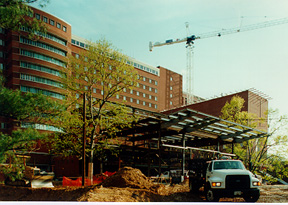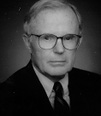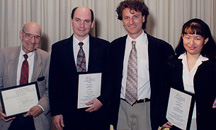Published monthly for CC employees by Clinical Center Communications
May 1998
ClinPRAT
Digital TV worries
people
New job for Graeff
Recycling easier
From the director
News briefs
|
|

Going up
The structural steel for the south entry is up, and work continues on
attaching the corrugated metal deck for the floors and roof, as well as
minor structural detailing. Continuing miscellaneous work includes building
the concrete block wall for the east corridor, pouring a concrete foundation
wall for the stairs, and installing drain pipes .
New program expands training in clinical pharmacology
The Clinical Center has joined forces with the National Institute of
General Medical Sciences (NIGMS) to re-institute training in clinical pharmacology
at the NIH.
Aimed at increasing the dwindling number of clinical pharmacologists
in the nation, the Clinical Pharmacology Research Associate Training (ClinPRAT)
Program will emphasize the application of laboratory pharmacology, biostatistics,
pharmacokinetics, and chemistry to the study of drug actions in humans.
The new program is an outgrowth of the clinical pharmacology option that
was part of NIGMS's Pharmacology Research Associate Training until 1995.
"There is a shortage of clinical pharmacologists in academic medical
centers, the pharmaceutical industry, and government agencies," said
Dr. Arthur Atkinson, CC senior advisor in clinical pharmacology. "Many
people are concerned that so few doctors receive exposure to this area
during medical school training, and we hope that this program can develop
a cadre of scientists with the capability to conduct both basic and applied
clinical pharmacology research."
The training involves four components: research training, mentoring,
didactic course work, and clinical rounding.
After entering the program, trainees will select a research preceptor,
with whom they will work directly. Another crucial component of the program
is mentoring. Mentoring has proven to play a large role in the development
of successful physician scientists, and trainees will also be assigned
a mentor who will play an advisory role throughout their training.
During the first year, trainees will enroll in both the core course
in "Introduction to the Principles and Practice of Clinical Research"
and a new course on "Principles of Clinical Pharmacology," designed
to cover topics such as pharmacokinetics, drug metabolism and transport,
assessment of drug effects, drug therapy in special populations, and drug
development.
During clinical rounds, trainees will shadow clinical pharmacist specialists
who are assigned to patient-care units in the Clinical Center.
The CC's Dr. Atkinson headed the development of the program. He previously
worked with Northwestern University for 24 years, where he served as director
of the clinical pharmacology program, and has more recently been at the
Upjohn Company, where he was in charge of the clinical development of drugs.
"I am aware firsthand of the need in academia for people with this
kind of training," said Atkinson. "And the CC is the perfect
place because it combines laboratory research and clinical investigation
in a unique setting that is a wonderful environment for someone who wants
to be a physician scientist."
An NIH steering committee will guide the development of the program.
Members include: Dr. Atkinson, chair; Dr. Alison Cole and Dr. Rochelle
Long, NIGMS; Dr. Carmen Allegra, NCI; Dr. Charles Daniels, CC; Dr. Robert
Dedrick, ORS; Dr. H. Clifford Lane, NIAID; Dr. Arthur Levine, NICHD; Dr.
Sanford Markey, NIMH; and Dr. Allen Spiegel, NIDDK.
The new course in Principles of Clinical Pharmacology is set to begin
in September 1998. The ClinPRAT program will premiere in July 1999.
index |
Unexpected disruptions accompany some digital TV broadcasts,
but the Clinical Center's prepared
Within the next six months, Washington D.C., is scheduled to join more
than 10 other cities nationwide to begin digital television broadcasts,
known to many as the next wave in technology.
But this innovation in broadcasting had some startling consequences
for a hospital in Dallas last month. Heart monitors throughout the building
suddenly went off-line, causing no harm to patients, but concern for staff
who took hours to determine the cause. According to officials there, the
disruption in critical monitoring equipment was traced to a local television
station testing their digital broadcasting system.
As a result of the potential for similar problems, federal regulators
have beefed up warnings about digital signals, placing health care facilities,
broadcasters, and manufacturers on alert.
"The digital television issue is part of a larger issue for hospitals,
that is, electromagnetic interference (EMI)," said Dr. Michele Evans,
CC environmental safety officer. "During EMI, energy from one device
can interfere with the operation of medical equipment, resulting in an
interruption of its normal performance or damage to its internal components."
Several years ago, the Food and Drug Administration (FDA) advised cardiologists
of the risks to certain pacemaker patients of using digital phones.
"We aren't alone in our concerns, but at the same time, wireless
technology has so many advantages that there are ways to minimize the risks,"
said Evans.
According to the FDA, interference involving telephones occurs mainly
if the phone is less than six inches from the pacemaker and in only a small
group of individuals.
"EMI poses a health hazard for the very small minority of pacemaker-dependent
patients-that is, those who depend heavily on the pacemakers to maintain
the heart's rhythm. It would be of less concern for the vast majority of
pacemaker wearers, who are not pacemaker-dependent."
Rather than ban the use of all cellular phones, as some hospitals have
done, the CC Safety Committee consulted with physicians in the NHLBI and
Critical Care Medicine Department, and decided to focus on higher risk
areas. The use of cellular phones was therefore restricted in the 10D,
2J, and 7E patient-care units.
But as Evans pointed out, cellular phones aren't the only source of
wireless signals. "Two-way radios such as those used by the fire department,
police, and maintenance, as well as pagers and wireless nurse call systems
can also cause a problem," said Evans.
As the digital television signals are about to begin being transmitted
nationwide, the Federal Communications Commission and the FDA are informing
hospitals, many of which are trying to make sure that the technology can
be introduced without harming the equipment that the patients depend on.
Closer to home, the CC is investigating options for upgrading communication
systems for use by employees. A workgroup, including safety, biomedical
engineering, and information systems, has been established by the CC to
look more closely at these issues.
"Here at the Clinical Center we are being cautious," said
Evans. "We're implementing an approach to show that not only have
we looked at the risks but we have assessed them to the point where we
reach a good balance between safety and innovation."
If you suspect EMI, call the CC biomedical engineering department at
6-1311. (by LaTonya Kittles)
index |
|
People:
ARRS honors Doppman's service with the gold
 Diagnostic Radiology Department's Dr. John Doppman
was recently named one of three recipients of the 1998 Gold Medal award
from the American Roentgen Ray Society (ARRS). Diagnostic Radiology Department's Dr. John Doppman
was recently named one of three recipients of the 1998 Gold Medal award
from the American Roentgen Ray Society (ARRS).
Doppman currently specializes in interventional radiology and also serves
as a clinical professor of radiology at the George Washington University
School of Medicine and a consultant to the National Naval Medical Center.
Doppman has authored more than 489 scientific articles, and last year
was awarded a Gold Medal Award for exceptional service to the field of interventional
radiology from the Society of Cardiovascular and Interventional Radiology.
The ARRS awards, bestowed to honorees for their distinguished service
in radiology, were presented last month.

At the circus
More than 10,000 folks attended the R&W's premiere for the Ringling
Bros. and Barnum & Bailey Circus at the MCI Center, an event that netted
$10,000 for NIH charities. About a thousand patients from the CC and other
local hospitals were guests. Joining the fun were Walter Jones, CC deputy
director for management and operations, with his children, Adam and Amanda. |
|

CC volunteers were recognized during the Fifteenth Annual Volunteer Service
Awards Ceremony on April 21 in Lipsett Amphitheater.
Among those honored included (above from left) Eugene Streicher, Tom
Locroft, and (at right) Bonny Chao. Many friends and colleagures of the
honorees attended, including Frank Lucas (third from left).
 During the ceremony, Andrea Rander (left), director
of volunteer services, and Nelva Reckert, CC volunteer performed their rendition
of "Side by Side," to highlight the importance of volunteering
and helping others. During the ceremony, Andrea Rander (left), director
of volunteer services, and Nelva Reckert, CC volunteer performed their rendition
of "Side by Side," to highlight the importance of volunteering
and helping others.
index |
Former ISD head takes on new NIH challenge
Alan Graeff, who served as chief of the CC's Information Systems Department,
has been named by NIH Director Dr. Harold Varmus as the first chief information
officer (CIO) of NIH.
Graeff will work with the NIH community to develop a vision and set
of goals for information technology (IT), establish an integrated IT architecture,
implement investment planning for IT, and develop long-term strategies
for making the best use of IT resources at NIH. In his new role, Graeff
will head the newly formed Center for Information Technology (CIT), which
combines the Division of Computer Research and Technology (DCRT), the Office
of Information Resources Management (OIRM), and the Telecommunications
Branch (TCB).
By creating the center and appointing a CIO, Varmus implemented two
major recommendations of the NIH information technology central committee
on themanagement of NIH's computing, networking and telecommunications
resources. The committee recommended appointment of a chief information
officer to head a center that would address all existing NIH information
technology and related functions and clearly define responsibilities for
central leadership and service across all NIH. Varmus will be appointing
a board of governors that will work with Graeff to define the CIT mission.
"The CIO appointment and the formation of the Center for Information
Technology will facilitate the development of effective strategies, policies
and standards for information technology, a resource that is critical to
the efficient conduct of NIH research and administration," Varmus
said.
Graeff has a wide range of experience developing successful IT projects
that have a major impact on how biomedical research is conducted at NIH.
"This experience gives Al a clear understanding of the needs of both
scientists and administrators for information technology. He brings a record
of outstanding leadership and management of information systems to his
new role as CIO," added Varmus.
Since 1995, Graeff served as chief of the Clinical Center's information
systems department, where he oversaw a major IT reorganization.
In his prior position as chief of NIAID's technical systems section,
Graeff was responsible for building the institute's first wide area network
comprising 12 locations across the country and serving 1,400 computer users.
He also designed and implemented an NIAID acquisition workflow system that
streamlined the institute's acquisition and planning processes.
In earlier positions, Graeff worked as a biologist for NCI's Metabolism
Branch and NIAID's Laboratory of Cellular Immunology. He holds a B.S. in
distributed sciences from American University.
"I look forward to the tremendous challenges and possibilities
that I know exist for IT at NIH. As we begin the process of merging TCB,
OIRM and DCRT into a single organization, I plan to create a center of
excellence built upon a positive and constructive partnership with the
NIH community, one that provides a high level of customer satisfaction,"
said Graeff.
The CC information systems department is now headed by Dr. Stephen Rosenfeld,
who is acting chief. (by Joan Chamberlain)
index |
 Watch for this tidy collection of recycling containers.
They'll help make the job of reducing waste and reusing resources easier. Watch for this tidy collection of recycling containers.
They'll help make the job of reducing waste and reusing resources easier.

|
CC renews efforts to make recycling easy
Did you know that recycling is more about reducing and reusing than
it is collecting?
When you reduce your consumption of goods, you reduce the need to recycle
or to dispose of solid waste. Similarly, when you reuse a product, you
postpone the need.
How do you reduce waste? Try sending electronic transmissions or photocopying
on both sides of the paper.
How do you reuse? Use travel mugs instead of styrofoam cups, or reuse
three-ring binders, paper clips, and alligator clips instead of using new
ones.
Look around your workspace and discover many opportunities to reduce
and reuse. Your initiative and creativity are key in reducing consumption
and reusing products.
The CC, along with other institutes, has initiated a recycling program
designed to save resources, reduce pollution, and promote environmental
ethics. The NIH Environmental Protection Branch (EPB) can help teach you
how it's done.
This month, the CC will make recycling bins available for staff, to
make it easier for everyone to join in the effort. Thanks to the collaborative
efforts between the EPB and the CC Housekeeping and Fabric Care Department
staff, led by Henry Primas, the recycling program is in full swing.
Throughout the building, metal recycling containers are now located
in the corridors. These fire-safe containers will house white office paper,
aluminum cans, mixed paper (newspapers, magazines, journals, mixed-color
paper), and commingled materials (metal, glass, plastic). Where appropriate,
containers for pipette tip racks and styrofoam peanuts will be provided.
Staff can also further recycling efforts by rinsing out beverage containers
before depositing them in the bins.
Inside CC offices, cardboard desk-top containers will be available to
collect white office paper. Staff will be asked to empty these boxes into
large containers, which also will be placed in all departments.
Outside the CC, three large recycling containers will be situated near
busy pathways to gather the recyclables of people entering or leaving the
Clinical Center.
The recycling effort also targets cardboard. Staff are asked to remove
packing materials and flatten the boxes so that the housekeeping staff
can load the boxes onto carts and move them to the loading dock for compacting.
The recycling goals of NIH have come a long way since 1989, when institutes
recycled only white office paper and aluminum cans. But now, to meet the
challenge of Montgomery County's mandate for all county businesses to reduce
their waste by 50% by the year 2000, the NIH voluntary recycling program
will depend on the support and assistance of all employees.
Thoughts and comments on the program are welcome, program organizers
note. Contact them with suggestions for a container location or to volunteer
as an area recycling coordinator.
The NIH Environmental Protection Branch is responsible for recycling
and waste collection. For more information, call Dave Crook at 6-7990 or
visit the recycling web site at <http://www.nih.gov/od/ors/ds/recycle/index.htm>.
(by Kelly Simons, who assists NIH with recycling efforts.)
index |
Measuring performance: A key to working better
|
|
*The mission: The Clinical Center is the clinical research facility of NIH.
As a national resource, it provides the protocol-specific patient care,
services, training, and environment needed to initiate and support the clinical
research sponsored by the individual NIH institutes.
**Long-range goals: Excellence in clinical research; quality of patient care; and cost
effectiveness and efficiency. |
|
by Dr. John I. Gallin, CC director
Consider the jetliner's control panel. It's designed to offer at a glance
each critical indicator that the pilot needs to keep the jet on course.
The pilot's charge is to constantly evaluate each bit of information-from
the approach of unexpected tail winds to a control-tower order to change
course-and make the necessary adjustments to reach the final destination.
Every action the pilot takes has the potential to compromise the integrity
of the jet's physical structure, the safety of its passengers, and the flight
crew's ability to get the job done on time and within the budget and time-frame
available to do it.
In many ways, a manager's job is much like that of a pilot's. Think about
it like this: Both the manager and the pilot have an ultimate destination.
Getting there is the mission*. Plotting a course along a series of goals**
provides the map.
In order to stay on course, the pilot depends on a constant flow of measurements,
information about where the jet is, where it's going, how it's getting there,
and why.
That's the same collection of measures that managers need to guide an
organization. They are measures that an organization's individual employees
need in order to match performance with requirements. And, they are the
same measures that tell us if we're doing what our patients and institute
partners expect.
We're now building a mechanism to better capture that information here
at the Clinical Center. It's a performance measurement system, initially
developed at the department heads' retreat earlier this year. The system
will allow us to tailor a comprehensive, multi-level instrument panel to
continuously measure and display the critical pieces of information the
organization needs in order to stay on course.
It's a system that will allow us to define, collect, and monitor the
tangible, measurable information we need to develop and refine goals.
This approach, rooted in the executive adage that "you can't manage
what you can't measure," should help us all worker better, smarter,
and more responsively and efficiency. index |
News briefs:
Mammography screening offered
Mobile mammography screening at NIH will run through July 1. It's open
for all NIH employees (including contractors, visiting scientists, and
volunteers) and their families.
The van will be near building 31 on May 14 and 22; near building 45
on May 19 and 20 and July 1; at Rockledge on June 2; at EPN on May 21,
and near the CC on May 28 and 29.
The van will be at each site 9:30 a.m. to 4 p.m.
The mobile screening program will be conducted by the George Washington
University (GWU) Breast Care Center. The screenings will be performed by
female technologists. A board-certified radiologist specializing in mammography
will interpret the films. The results will be reported to you and your
doctor.
The cost is $138. GWU will bill some insurance companies directly.
To schedule, call the Breast Cancer Center at 202-994-9999. For more
information about breast cancer and mammography, call 1-800-4-CANCER.
CC featured
The Clinical Center is again featured in Washingtonian magazine. The
May issue story "What's Wrong With Jessica?" offers insight into
the unique resources provided by and through the CC.
Conference set
The CC Nursing Department and the National Institute of Nursing Research
will co-sponsor a conference, "From Discovery to Practice-What Does
It Take to Bring About Changes in Health Care?" The conference will
be held 9 a.m. to 4:30 p.m on May 13 in Lister Hill Auditorium, building
38A.
Save with bonds
The 1998 Savings Bond campaign will begin on May 11. Interested in buying
savings bonds? Contact your department's canvasser.
ICDs become ICs
Forget ICD. It's now IC. Since the creation of the Center for Information
Technology, no divisions report directly to the NIH director.
Take your child to work day slated
NIH will observe Take your Child to Work Day on May 28. Participants
will meet at 9 a.m. in Masur Auditorium. For more information, and to register,
visit their website (<http://TakeYourChildToWork.nih.gov/>)
or contact O.H. Laster at 6-6302.
Sleep study needs
The National Institute of Mental Health is looking for male and female
volunteers. Volunteers must routinely sleep 9 or more hours and be between
the ages of 20 and 30. To participate, volunteers for this sleep study
must have no sleep disturbances and no history of mental illness.
Volunteers must be in good general health and not taking any medications,
including birth control pills. For more information, call 6-6981.
Board to convene
The CC Board of Governors is scheduled to meet on Wednesday, May 27,
at 9 a.m. in the Medical Board Room.
Breast cancer quilt display continues
The NCI patient-made breast cancer quilt will be on display in the lobby
adjacent to the special events office on April 29-May 11. Also on display
will be the Art for Recovery Breast Cancer Quilt Project.
Training offered
The CC education and training section will offer, "Career Enrichment
Resources," on May 20, 9 a.m. to noon, in the first floor conference
room at 6100 Executive Boulevard. Attendees will learn about programs that
are available to enhance performance in their current duties and explore
avenues for career advancement. To register, call 6-1618.
Fogarty correction
Weihan Wang, Fogarty fellow in critical care medicine, won the Henry
Christian award from the American Federation of Medical Researchfor the
most meritorious abstract in immunology. Last month's issue incorrectly
identified Dr. Bob Danner as the recipient.
index
Editor:
LaTonya Kittles
Clinical
Center News, 6100 Executive Blvd., Suite 3C01, MSC 7511, National
Institutes of Health, Bethesda, Maryland 20892-7511. (301) 496-2563. Fax:
402-2984. Published monthly for CC employees by the Office of Clinical Center
Communications, Colleen Henrichsen, chief. News, articles ideas, calendar
events, letters, and photographs are welcome. Deadline for submission is
the second Monday of each month.
top
| cc home page | nih
home page | |
|

